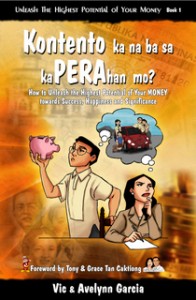An old saying goes, “It doesn’t matter where you came from. It doesn’t matter where you are right now. What matters is where you are headed.”
Hindi na mahalaga kung baon ka sa utang ngayon. It doesn’t matter kung pinahirapan mo ang sarili mo noon. Bakit? Kasi nakaraan na iyon. Wala ka nang magagawa.
Pero what matters is where you are headed. Ang mahalaga ay kung saan mo gustong pumunta ngayon. How would you like to see your financial status a month from now? One year from now? Five years from now? Ano ang mga financial goal mo? Mayroon kaming naging participant sa seminar before at ito ang kanyang naging financial goals:
Goal 1: Mula ngayon, hindi na ako mangungutang. “One of the best decisions we have made in our lives, sa amin pong pamilya, ay ang desisyon naming hindi na kami mangungutang. Grabe! Dati ay lubog kami sa utang. Mahirap ang lubog sa utang. Kaya nag-desisyon kami na hindi na mangutang, at dahil doon, hindi na lumaki ang aming utang!”
Goal 2: One year from now, I will be out of debt. “Eh, Sir, kasi may mga utang ako ngayon. Kinompute ko na within one year ay makakabayad na ako ng aking mga pagkakautang.”
‘Yung sa iba, maaring two years o three years bago makabayad, depende sa lalim ng pagkakautang. Kaming mag-asawa, ang goal namin ay mabayaran ang aming mga utang within one year. Sa awa ng Diyos, within one year ay nakabayad po kami.
Goal 3: Two years from now, I will have P250,000 in my bank account. Ito ang gagawin mo kapag nakabayad ka na sa lahat ng iyong pagkakautang. Puwede ka nang magsimulang mag-save. Depende sa iyo kung magkano ang kaya mong i-save sa loob ng isang taon. Napaka-importante ng goal na ito.
Goal 4: Five years from now, I will have my own 5-bedroom house. Pero kailangan ay alam mo kung puwede nang bumili ng bahay o hindi pa. May kakilala kami, noong bumili siya ng bahay, lalo siyang naghirap at nagkabaun-baon sa utang. Kung hindi pa kaya, huwag munang bumili.
These are just examples of financial goals. Maari kang gumawa ng iba pa. Just remember: “Commit to the Lord whatever you do, and he will establish your plans.” (Proverbs 16:3 NIV)
Shared by Coach Amos
0923-1520501
Like: http://www.facebook.com/coach.amos
Follow: http://twitter.com/coach_amos
Visit: http://coach-amos.blogspot.com
(Repost/Excerpted from Vic and Avelynn Garcia’s book entitled Kontento Ka Na Ba Sa KaPERAhan Mo? available in National Bookstore, Powerbooks, Fullybooked, OMF and other leading bookstores nationwide. Also available in Unleash International Bookstore. For details, please contact 0922-UNLEASH (8653274) or 664-0892, 632-0148 local 8002-8003.)
Vic Garcia is currently the President and CEO of Unleash International Corporation, a high-tech, high-touch, high-impact training company whose main mission is to unleash the highest potential in people towards success, happiness, and significance through licensed and originally authored, world-class, high-impact training programs.
Vic has been in the business for more than 20 years and has gained the trust and confidence of countless organizations. He is also the author of the Unleash Workbook and Unleash Learning Systems. His area of competence varies from work and life improvement, financial management, leadership, system, productivity, teambuilding, and other specialized seminars that will unleash the highest potential in people. He served as a consultant and a management coach to a number of CEOs and leaders of different companies. He is often invited to different television and radio programs to share his expertise in unleashing the highest potential in people.
Learn and apply practical ways of effective financial management through easy and doable techniques when you follow this series weekly. Follow Vic on Twitter, @UnleashMoney. Also visit www.unleashinternational.com and Unleash International on Faceboook, www.facebook.com/unleashinternational.








